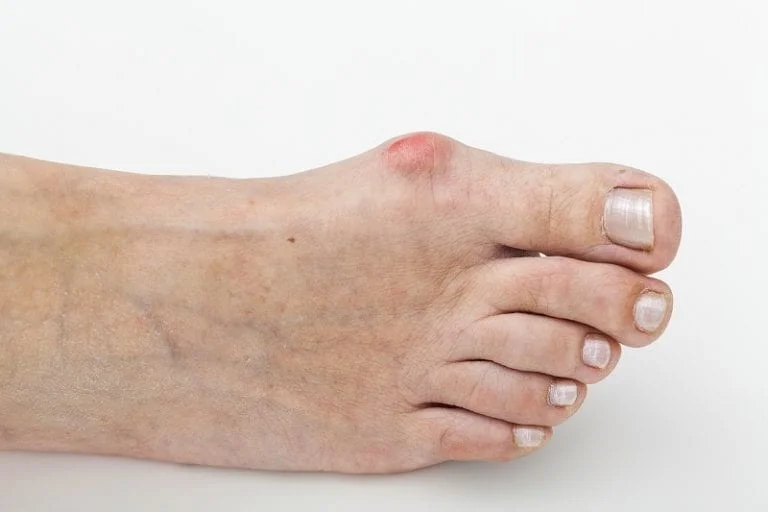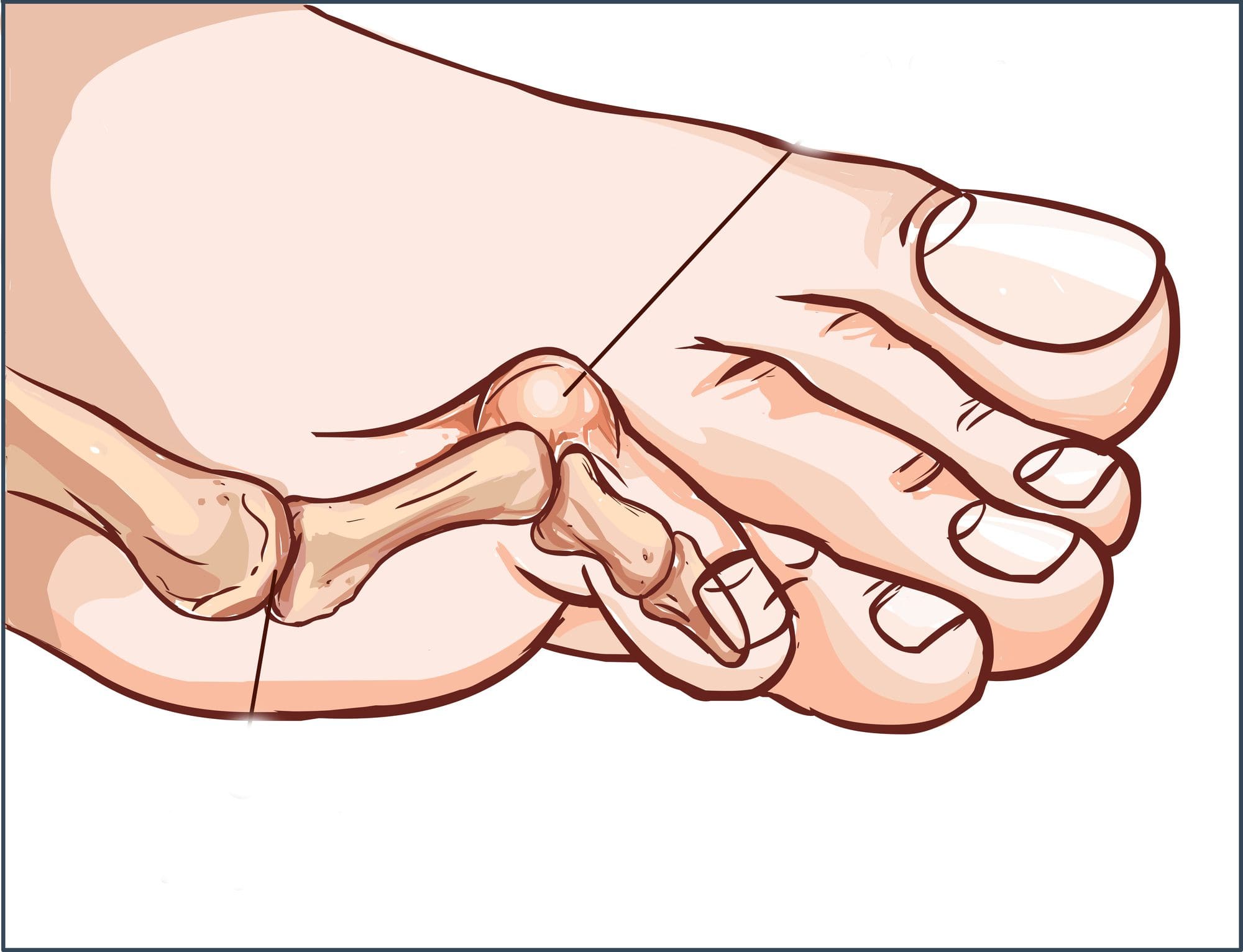Why do bunions appear?
Bunions, or hallux valgus, are a common foot deformity that develops primarily from genetic factors that influence the structure of the foot and from prolonged use of improper footwear that squeezes or pushes the toes into abnormal positions. These factors can alter the natural alignment of the foot bones, leading to the formation of bunions. In addition, biomechanical changes during gait and shoe pressure can exacerbate this condition.

What factors influence the appearance of bunions?
Bunions can develop due to several factors, including anatomical features of the foot, external factors such as improper footwear, and systemic conditions that affect the structure and function of the foot.
External or extrinsic factors
- Footwear: Narrow-toed, high-heeled shoes: Wearing this type of footwear can put undue pressure on the feet, pushing the big toe into an abnormal alignment that promotes bunions.
- Body weight: Impact of overweight: Studies indicate that higher body weight increases the load and pressure on the feet, which can alter their structure and increase the risk of bunions.
Intrinsic factors
Hereditary factors: There is a notable genetic predisposition, especially visible in cases of hallux valgus that appear in youth.
Differences by sex:
- Gender ratio: According to studies, such as one conducted by the Autonomous University of Barcelona, the ratio of affected women to men is 15:1.
- Influence of footwear: Narrow, high-heeled shoes, which are more common in women, are considered to influence the prevalence of bunions in this group.
- Anatomical characteristics: Women tend to have a rounder and smaller metatarsophalangeal joint of the first toe, resulting in less stability and an increased risk of developing bunions.
Additional statistics: A recent study suggests that more than 70% of people with bunions have a family history of the problem, highlighting the strong genetic influence.
Systemic factors related to the progression of bunions, consider the following aspects:
- Elastic or lax ligaments: Ligament laxity may contribute to the development of bunions due to the structural instability it causes in the feet.
- Age: Prevalence according to age: Bunions are more frequent between 40 and 60 years of age, a period in which degenerative conditions of the foot may begin to manifest themselves.
- Metatarsus primus varus: This condition, where the first metatarsal deviates inward, increases the risk of bunions.
- Anatomical variants of the first toe joint: Variations in the structure of this joint may predispose individuals to develop bunions.
- Flat feet: Lack of proper arch in the feet can lead to uneven distribution of weight and pressure that favors the formation of bunions.
- Short or retracted Achilles tendon: A short Achilles tendon can affect the biomechanics of the foot, promoting conditions that lead to bunions due to an altered gait.
What are the non-surgical treatments available for bunions or hallux valgus?
At Clinica San Roman, we offer several non-surgical options to prevent and treat bunions, especially useful in the early stages of the deformity. These treatments include adjustments in walking habits and choice of footwear, as well as orthotic and physiotherapeutic measures designed to relieve pain and improve foot function.

Changes in footwear and other non-surgical measures:
Selection of appropriate footwear:
- Opt for shoes with a wide toe box to avoid toe compression.
- Choose shoes with a heel of less than 4 cm to reduce pressure on the forefoot.
Use of pads:
- Incorporate special pads in the shoe to relieve pressure on the bunion and provide additional support.
Orthopedic footwear:
- Consider wearing physiologic toe shoes or orthopedic shoes designed to better conform to the natural shape of the foot and relieve pain.
Application of local cold:
- Use cold compresses on the affected area after prolonged periods of activity to reduce swelling and relieve pain.
Exercises
Exercises for the toes:
- Perform movements involving the toes to improve flexibility and strengthen the muscles around the joint.
Strengthening of the flexor of the first finger:
- Mobilize the metatarsophalangeal joint of the first toe through specific exercises and stretching to increase strength and mobility.
Elongation of the Achilles tendon:
- Practicing stretching exercises for the Achilles tendon, which can help relieve stress on the bottom of the foot and improve overall foot alignment.
These exercises are part of a preventive and therapeutic approach to manage and possibly reduce the risk of developing bunions.
Surgery to treat bunions:
Need for surgery: Surgery is considered when conservative treatments fail to relieve pain or stop progression of the forefoot deformity. Effectiveness of surgery: Surgical intervention is effective and definitive in correcting bunions, provided proper technique is used and all related deformities are corrected. Objectives of bunionette or hallux valgus surgery:
- Symptom relief: Reduces pain and chafing injuries.
- Restore motor function: Corrects gait problems.
- Correct the deformity: Correctly align the foot.
- Aesthetic reasons: Improves the appearance of the foot.
Deformities corrected by surgery:
- Reduce the intermetatarsal angle: Decrease the angle between the metatarsals.
- Reposition the metatarsophalangeal joint: Adjust the joint to improve its function.
- Correctly position the sesamoids: Place these bones under the metatarsal head.
- Improve the load-bearing capacity of the first phalanx: Strengthens the bone structure to adequately support weight.
- Align the hallux: Place the big toe in a straight position.
- Control or correct causative factors: Addresses the underlying causes of the deformity.
Bunion surgery with osteotomy
Location of osteotomies: Osteotomies are performed in key areas to maximize correction of the deformity. In the case of hallux valgus, these can be performed above or below the deformity, depending on its severity and location. Types of osteotomy:
- Distal first metatarsal osteotomy: This cut is made in the distal part of the first metatarsal to realign the bone.
- Osteotomy of the base of the first phalanx: This is performed at the base of the first toe to correct additional deviations.
- Proximal first metatarsal osteotomy: This cut is made closer to the midfoot for larger and more complex adjustments.
Customization of the procedure: Osteotomy techniques are selected and adapted according to the degree of severity of the deformity, the patient’s pathological history and the presence of other associated deformities.
What is hallux valgus? Why do bunions appear?
Hallux valgus, commonly known as bunion, is the most prevalent deformity of the forefoot, characterized by a series of structural changes in the foot:
Medial deviation of the first metatarsal: The first metatarsal is displaced towards the inside of the foot.
Deviation and lateral rotation of the first toe: The big toe deviates and rotates toward the other toes, contributing to the visible prominence known as a bunion.
Exostosis of the head of the first metatarsal: This bony prominence is the most notable feature of a bunion.
Progression: Hallux valgus is a deformity that tends to progress over time, and conservative treatments rarely stop its progression, often leading to the need for surgical intervention.
In addition, this condition can alter gait and is frequently associated with other foot deformities, such as claw toes.
Studies indicate that hallux valgus affects approximately 23% of people between the ages of 18 and 65 and 36% of people over the age of 65, being much more common in women than in men (Nix, Smith, & Vicenzino, 2010) .

What are claw toes?
Claw toes are a common toe deformity characterized by abnormal joint position:
Flexion of the base joint: The joint closest to the base of the finger flexes upward.
Downward bending of the middle joint: The middle joint of the finger bends downward, giving the finger a claw-like appearance.
This deformity is caused by a muscle imbalance in the feet and can present as flexible, allowing some movement, or as rigid, where the toe remains fixed in the claw position. Although in some flexible cases physical therapy and orthotics can be used to alleviate the symptoms, surgical intervention is often necessary to fully correct the deformity.
Statistically, finger deformities, including claw toes, have been found to be very common and may affect approximately 20% of the adult population, being more frequent in women and older people (Burns et al., 2005).
For an effective diagnosis and treatment of claw toes, we recommend a consultation at Clínica San Roman, where we can offer treatment options tailored to each case.
Burns, J., Crosbie, J. & Ouvrier, R. (2005). Effective Orthotic Therapy for the Painful Cavus Foot. Journal of the American Podiatric Medical Association, 95(3), 247-251.
How is the operation for hallux valgus and claw toes?
The hallux valgus (bunionette) and claw toe operation is a surgical procedure that addresses both foot deformities. Since it is common for bunions to coexist with deformities such as claw toes, it is crucial to perform a detailed evaluation of each patient to plan a surgery that effectively corrects all associated problems. This comprehensive approach helps ensure the success of the procedure and minimizes the risk of subsequent recurrences or complications.
Statistics indicate that combined foot deformities such as hallux valgus and claw toes affect a significant proportion of the population. For example, one study shows that up to 60% of patients with hallux valgus also have some form of lesser toe deformity (Doty et al., 2014).
To ensure the best possible results, at Clinica San Roman, we adopt advanced surgical techniques and provide complete postoperative follow-up. If you are considering surgery to treat these deformities, we invite you to consult with our specialists for a personalized evaluation.
Doty, J.F., Coughlin, M.J., Weil, L., & Nery, C. (2014). Efficacy of Correction of Hallux Valgus and Metatarsus Primus Varus With Hallux Valgus Surgery. Journal of Bone and Joint Surgery, 96(19), 1585-1590.

Prior to hallux valgus and claw toe surgery, it is essential to perform a detailed evaluation:
Clinical History and Radiological Evaluation:
- Taking a complete medical history.
- Radiological evaluation to determine the severity of the forefoot deformity and detect other possible complications.
Interrogation and Physical Examination:
- Interrogation: Discussion of symptoms and evolution of the deformity.
- Inspection: Observation of the foot in the sagittal and transverse planes.
- Mobility: Check the mobility of the first toe joint.
- Associated pathologies: Identify subluxations, paronychia, hyperkeratosis, and other joint pathologies.
- Palpation: Assess for swelling, pain, presence of exostoses, crepitus and other signs of osteoarticular alterations.
Stability Evaluation:
- Determine hypermobility or instability of the first finger.
- Assess range of motion in different planes.
- Inspect additional deformities in other fingers.
Radiology:
- Measurement of the four basic angles of the foot and evaluation of bone alterations in other toes.
This thorough evaluation is crucial to properly plan the surgical procedure and to anticipate any potential complications.
What to do to eliminate bunions?
To effectively eliminate bunions, surgery is the most definitive option. Non-surgical treatments such as the use of appropriate footwear, protective pads and orthotics can help alleviate symptoms but do not eliminate the existing deformity.
How to prevent bunions from growing?
To prevent the growth of bunions, it is advisable to wear shoes with enough room for the toes and avoid high-heeled, narrow-toed shoes. Specific exercises to strengthen the feet and improve alignment may also be beneficial.
What types of bunions are there?
The most common types of bunions include the typical bunion or hallux valgus, which affects the big toe, and the tailor’s bunion or bunionette, which develops at the base of the fifth toe.
When should bunion surgery be performed?
Bunion surgery is considered when there is persistent pain that interferes with daily activities, the deformity is severe, and non-surgical treatments have not relieved the symptoms. The decision should be made in consultation with an orthopedic or podiatric specialist who will evaluate each case individually.
Bibliography
- Menz, H.B. et al., 2021. ‘Footwear, foot orthoses and strengthening exercises for the non-surgical management of hallux valgus: protocol for a randomised pilot and feasibility trial’. Journal of Foot and Ankle Research. Available at: https://jfootankleres.biomedcentral.com/articles/10.1186/s13047-021-00476-4 (Accessed: 23 April 2024).
- Frey, C. et al., 2021. ‘Foot Disorders, Foot Posture, and Foot Function: The Framingham Foot Study’. PLOS ONE. Available at: https://journals.plos.org/plosone/article?id=10.1371/journal.pone.0259948 (Accessed: 23 April 2024).
- Coughlin, M.J. et al., 2002. ‘Hallux valgus with and without metatarsalgia in women: a comparative study’. SpringerLink. Available at: https://link.springer.com/article/10.1007/s001320050043 (Accessed: 23 April 2024).
- Hirslanden, 2023. ‘Hallux valgus – diagnosis and treatment’. Hirslanden Switzerland. Available at:https://www.hirslanden.com/global/en/home.html (Accessed: 23 April 2024).